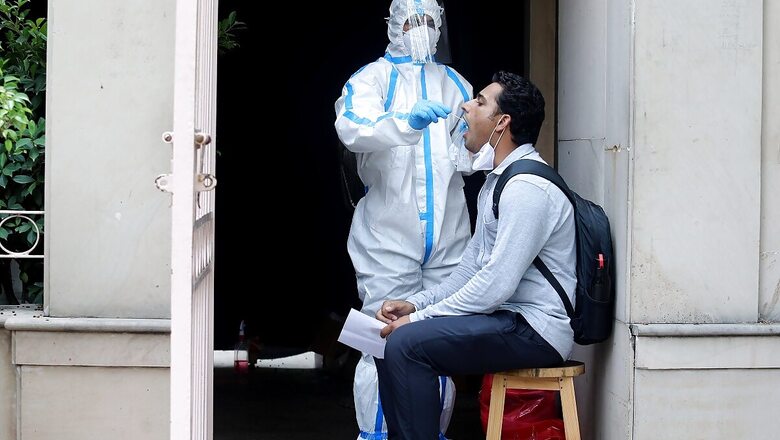
views
The Indian Council of Medical Research (ICMR) has just released the findings of its national survey, estimating the prevalence of antibodies against the SARS-CoV-2 virus in the population. The survey, conducted in June-July 2021, reported a prevalence of 67.6 per cent in the general population aged over 6 years. This figure reveals a big jump from prevalence estimates of earlier surveys.
The first survey, in May-June 2020, reported only 0.7 per cent. The estimate went up to 7.1 per cent in August-September 2020. Between December 2020 and January 2021, as the first wave reached its nadir, the prevalence was noted to be 24.1 per cent. The 280 per cent increase, since this last survey, is principally due to the second wave that surged skywards during March-May 2021, though vaccination too commenced from mid-January to confer immunity on some. Children aged 6-9 years had 57.2 per cent seropositivity, while 61.6 per cent in the 10-17 year age group tested positive.
Antibody surveys are useful to gauge the extent of virus spread across the population. Viral detection tests, such as RT-PCR and Rapid Antigen Tests, detect only a fraction of the persons infected by the virus. They detect the virus during periods of active infection, when the virus is replicating. They do not detect old infections. Even in persons with active infections, these tests may report negative results due to modest sensitivity, unless repeated frequently. Persons who were infected but experienced no symptoms or mild indisposition, rather than clinically disconcerting illness, may not get tested at all. For all of these reasons, antibody surveys provide a better estimate of the percent population which was infected by the virus at any time prior to the date of the survey.
Several questions need to be asked while interpreting the results of antibody surveys. How representative were the surveys of the whole population? How accurate are the results in terms of false positives and false negatives? Does testing positive for antibodies in a survey provide assurance of immunity against fresh viral infection for the person? Do these antibodies promise protection against new variants? Does the latest survey suggest we are close to herd immunity across India?
Read between the Lines
Surveys are based on representative samples, since the whole population cannot be covered. Ideally, a sample of the population could have been tested in every postal code area of the country but that would be highly resource intensive and logistically challenging. Our constrained health system resources are better spent on a more easily manageable survey, in these pandemic times.
The recent ICMR survey covered 28,975 individuals randomly selected from the population and separately examined 7,252 healthcare workers. The sampling frame for the population survey covered 70 districts, across 21 states. While, they may be considered fairly representative of the 741 districts of India, some regional variations may be missed. Further, the rural sample may be more peri-urban than truly rural in some districts. Nevertheless, comparisons over different time periods are useful for examining viral exposure levels over time, if the same sampling frame is maintained.
ALSO READ | How to Stay Safe While Waiting For the Vaccine? Top Health & Policy Expert Answers
How accurate are the tests? The testing method used by ICMR during earlier surveys identified IgG antibodies against the nucleocapsid protein of the virus. The latest survey used the qualitative method for nucleocapsid and a more recently available quantitative test for the spike protein. The manufacturers of these IgG testing kits claim very high levels of sensitivity and specificity. A survey last year in Orange County, California, used a coronavirus antigen microarray kit (CoVAM) which quantitatively measures IgG and IgM antibodies against 12 antigens of the SARS-CoV-2 virus “unlike then available FDA authorised tests which detected antibodies against one or two antigens.” The CoVAM test also measures 53 antigens from other coronaviruses which can cause cross-reactivity through their antibodies. The problem of cross-reactivity is worth noting as four coronaviruses cause common cold, especially among children. Weighed against the possibility of false positive test results in our population, we have to recognise the probability of some false negative results too, because antibody levels may have faded and become undetectable in persons who were infected several months before the survey.
If we accept the prevalence estimates as highly accurate and widely representative, despite these quibbles, what does that say about immunity against fresh infections against the virus, both for the persons who tested positive, and for the whole population? Unfortunately, presence of the antibodies provides no guarantee of long-term protection against a fresh infection. The antibodies may disappear soon, especially in those who had a low viral load challenge during their infection or those whose status of health and nutrition did not permit a strong and long lasting immune response.
Even if memory T and B cells can reactivate the defences, we are still uncertain about individual variability in the strength and duration of such revived defence. While the tests identify presence of antibodies, they do not assess their ability to neutralise the virus. That requires other tests in a well-equipped laboratory. Viral neutralisation must be clearly demonstrated, especially when several variants have emerged against which there is reduced neutralising ability of antibodies produced by previous infection or vaccination and even of manufactured monoclonal antibodies. The Beta and Delta variants are of particular concern in this regard.
The Elusive Herd Immunity
While antibodies detected in a survey do not provide a guarantee of immunity against a fresh infection to individuals, they offer even less assurance of herd immunity at the population level. We have seen repeated claims of herd immunity in Delhi, Mumbai and Bengaluru, confidently made in 2020 and early 2021, proven wrong by the terrible second wave which came later. These erroneous predictions were made on the basis of misinterpreted antibody surveys. That happened elsewhere in the world too. The pandemic raged in Manaus, Brazil, even when a seropositivity rate of 76 per cent was reported in the population. As new variants emerge, the protection slips.
Further, herd immunity is a population attribute, not applicable to individuals. Better understood as herd protection, a high level of immune persons in any stable population blocks transmission of the virus to the minority who are not immune. That protective cordon is no longer available when a non-immune person moves to another part of the city or country where the population has not yet reached the herd immunity threshold (HIT) and the virus is in active circulation.
ALSO READ | Kappa or Lambda: Don’t Fear the Greek Alphabets, Follow COVID Norms and Get Vaccinated
We presently do not know what the HIT is for this virus in its wild ancestral form. That uncertainty has been amplified over time, as the threshold changes for each variant which displays a different level of infectivity. Compared to the uncertain strength and duration of immunity conferred by a natural infection, the immunity conferred by the vaccine is stronger and will probably last longer. However, even vaccine-induced immunity does not offer herd protection if an unvaccinated person travels to a region where vaccination rates have been low and the virus is circulating. So, it is best that every person gets vaccinated without betting his or her life on the uncertain charity offered by other people’s immunity.
Despite the inability to provide assurance of lasting immunity at either individual or population level, antibody surveys do serve a useful purpose. By providing estimates of changing numbers of infected persons in a relatively stable population, over different time periods, the surveys can tell us how effective our public health measures have been in containing viral transmission between the surveys.
The big jump in the latest survey bears testimony to the wide avenues we provided for the virus to travel and infect large crowds, between January and May this year. Even if the Delta variant came with higher infectivity, it could not have infected so many in such a short time but for our collective laxity in adopting disciplined personal behaviours and enforcing strict policy measures.
The ICMR report carries the caveat that one-third of the population are still susceptible to the virus, as they do not have demonstrable antibodies. For reasons stated above, the number of susceptible people will be higher, as some persons with antibodies will also lack protective immunity, especially against recent variants. So, it is imperative that we apply brakes to the viral transmission before the next survey, rather than slipping back into erroneous assumption of having attained an illusory armour of herd immunity. No reason to let the guard down, till over 80 per cent of the population is vaccinated.
Professor K. Srinath Reddy, a cardiologist and epidemiologist, is President, Public Health Foundation of India (PHFI). The views expressed in this article are those of the author and do not represent the stand of this publication.
Read all the Latest News, Breaking News and Coronavirus News here.



















Comments
0 comment